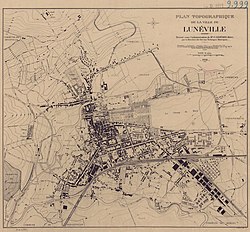Lunéville – Einville railway line
| Lunéville – Einville | |
|---|---|
|
City map of Lunéville from 1936
| |
|
Route, map 1908
| |
| Gauge : | 1000 mm ( meter gauge ) |
The meter-gauge railway line Lunéville – Einville connected Lunéville with Einville in the Meurthe-et-Moselle department in Lorraine in eastern France between 1902 and 1943 . Legally, in the early years it was a tram , from 1921 a railway .
course
The route began in the square in front of the Est train station , now the only train station in the city. There was a turning triangle here and, from 1911, a track connection to the also meter-gauge Lunéville – Blâmont – Badonviller (LBB) railway line that began here . At the station itself, trains operated by the Eastern Railway to Paris and Strasbourg as well as to Saint Dié . From here the steam tram trains drove north through the streets of the old town: via rue Carnot and Place Léopold, then via rue Banaudon a short distance to the west and again in a northerly direction via rue de la République, the Place du Château and the rue Chanzy. After crossing the Vezouze on the road bridge, the Lunéville-Jolivet station was reached through the Faubourg d'Einville (now Rue de la Résistance). From here there were two branch lines: a short rail connection to the south to the city's gasworks and one to the east to a mill on the outskirts of Jolivet . With the completion of the LBB in 1911, a route to its local train station in the east of Lunéville branched off from it in a south-easterly direction, creating a further connection between the two networks and at the same time enabling a large-scale bypass of the city center.
From Lunéville-Jolivet, the main route to Einville ran in a loop that extended far east to overcome the ridge north of the city. We continued west past the village of Bonviller - there was a stop here - and with an arch down into the valley of the Sânon , which was crossed with a bridge. At the destination, the route first led to the port on the Rhine-Marne Canal and then a short distance east to the terminus.
The operating center was the Lunéville-Jolivet station, the seat of the administration and the depot . In Einville there was a small, one-story station building, two turntables , a warehouse and a crane at the port. There were two other stops within Lunéville, Grande-Rue and Faubourg Einville.
history
Since the end of the 1870s there were considerations to build a railway line from Lunéville to Einville and Arracourt . In November 1899 a consortium of local investors formed the Compagnie du chemin de fer de Lunéville à Einville , which the French government approved to build a tram between the two towns. Traffic began on May 1, 1902, and the official inauguration ceremony took place one month later, on June 2.
The passenger trains were pulled by small steam locomotives and had several wagons, some open summer wagons were used. In terms of freight traffic, deliveries of coal that were reloaded from ships in the port of Einville in order to be transported to the Lunéville gasworks were of importance.
In the early 1920s, the railway was taken over by the department administration. It commissioned the Compagnie des chemins de fer départementaux de l'Aube , which was already responsible for LBB, with the operational management , at the same time the tram was legally converted into a railway for reasons of granting subsidies. In order to save costs, the company later used a gasoline-powered rail bus from Dion-Bouton with an associated two-axle trailer for passenger trains; freight traffic continued to be carried out with steam-hauled trains. After the mill closed in 1924, traffic on the remainder to the outskirts of Jolivet ceased.
On November 1, 1937, passenger traffic was discontinued and taken over by buses from the Rapides de Lorraine company, which extended the line to Vic-sur-Seille . Freight traffic continued until the beginning of 1943. The final shutdown took place at the same time as that of LBB by a decree of October 4, 1943, and the infrastructure was subsequently dismantled. The station building of the Lunéville-Jolivet train station was later used by the administration of a metalworking company. It was badly damaged in a fire in 2015 and is due to be demolished in October 2019. [obsolete] As of 2019, the small train station building in Einville is still there.
literature
- Le Tramway de Luneville a Einville. In: Magazine des Tramways à Vapeur et des Secondaires , Issue 25, 1983, ISSN 0150-116X
- Marc Gabriel: Le petit train de Lunéville à Einville et à Jolivet. Nancy 2012, ISBN 978-2-9537068-2-6
Web links
- Detailed illustrated report from 2012 on the railway, prepared on the occasion of an exhibition in Einviller: Part 1 and Part 2 (French)
Individual evidence
- ↑ a b c La gare: un peu d'histoire avant la destruction. L'Est républicain , August 28, 2019, accessed on October 12, 2019. (French)
- ^ Announcement of the French state of November 18, 1943 , p. 2966, accessed on Gallica on October 12, 2019. (French)
- ↑ Photos. A l'époque du tacot Lunéville-Einville. L'Est républicain, 23 August 2019, accessed on 12 October 2019. (French)


